The Experiment ![]()
by Bruce Cornet, Ph.D.
Table of Contents
Peer Review Questions and Answers
On 9 May 1994 John Macedo, Jr. and Bruce Cornet drove to Pine Bush, NY, in order to survey AOP activity at night.
|
|
A Japanese film crew was doing a special on the Pine Bush phenomenon with Ellen Crystall for Nippon Television. The film crew and Crystall showed up at West Searsville Rd. just before sunset. They took some video of us posing with our cameras. Then Macedo was interviewed in the field, because he could not make it back the next day for the staged interview.
|
On 10 May a helicopter was rented to fly Cornet and one of the Japanese cameramen around the area. The pilot was the late Ernie Kittner.
|
After initially travelling west, the pilot circled the hotspot clockwise (circular hexagonal Indian mound), then flew north. It was during that flight that the helicopter was buzzed three times by one or two AOP travelling at more than Mach 6, silently. Together all three events encompassed the hotspot.
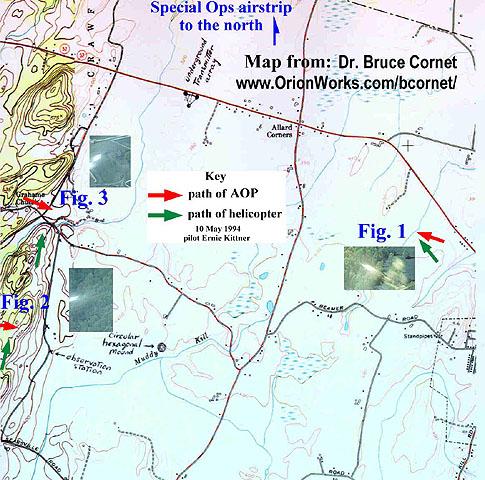
Only the first time (Fig. 1) when a tetrahedral-shaped craft flew within 100 feet of the helicopter was it bounced by a mild shock wave. There was no sonic boom, however. Incredibly, Cornet captured all three fly-by's on film. The AOP in Figure 2 was capture on both video and film, proving that it wasn't due to sun glare on the helicopter canopy. The objects were travelling so fast that all we visually saw was a flash of light as they passed in front of us. The first photograph taken is illustrated on the Index page. It almost freezes the object so that aspects of its shape and lighting could be discerned.
Figure 1.
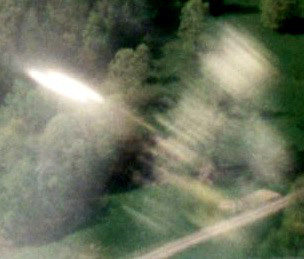
After the film crew and Crystall retired for the evening (on 9 May), Macedo and Cornet set up an experiment. Several times Cornet and Crystall had photographed the same AOP light(s) in the night sky, both taking time exposures. The images they got, however, showed significant differences. There was no mistaking shots taken at different times for the same event. Each pair of images showed the same treeline and the light doing the same aerobatics in the sky. But one picture contained some movement or feature that the other picture did not. Because the cameras of Crystall and Cornet were positioned within five feet of one another, and both were securely mounted on tripods, the differences appeared to originate at the light source, and not at the camera. In order to prove that this was the correct explanation, an experiment had to be conducted which would show conclusively that different cameras and individuals are given different images of AOP to view.
For this experiment to work, the cooperation of the assumed intelligence behind AOP would be required.
It has been a contention of skeptics that different descriptions of AOP by multiple witnesses of the same event is an indication of human fallibility and unreliability. But it is also possible that if AOP can manufacture custom patterns of shapes and lights for different observers, the intelligence behind such illusions can effectively shield or protect its identity by promoting uncertainty and confusion amongst humans.
For this experiment the two cameras were positioned a measured two feet apart. A Minolta XG-M single lens reflex 35mm camera and a 1989 Sears VHS camcorder (Model No. 934.53744950) were used. Both were securely mounted on tripods. The Minolta was operated by an electronic cable switch, while the camcorder had to be turned on by a switch on its control panel. Macedo operated the camcorder, while Cornet operated the Minolta.
The location for the experiment was the dogleg bend in West Searsville Rd., next to the Wilde farm. The tripods were set up on a lawn on the east side of the road, in a location Cornet had used repeatedly in order to minimize the number of variables. Using a tape measure, the camera bodies were positioned exactly two feet apart. Both cameras pointed in the same direction. Initially the cameras were pointed west, because that traditionally had been the direction from which most AOP fly-overs originated. Cornet stood to the left of his camera, while Macedo stood to the right of the camcorder. The time was about 9:15 pm.
The evening was cool and dry. The sky had a high cloud cover. At 9:22 pm Cornet spotted a pair of lights approaching from the west at an estimated altitude of about 1,500 feet. Macedo turned on the camcorder and began tracking the lights. Cornet took a series of time exposures as the AOP flew over them and then seemed to descend rapidly to the east, where it disappeared below the horizon. What Cornet saw approaching him was a pair of "very brilliant" yellowish white lights. As they approached they flared in typical "performance" fashion, then dimmed. Cornet thought Macedo was seeing the same thing, but got no response to his statement about the brilliance of the right light.
Timing of photographs.
Time Expos |
Time |
No. of Seconds |
Camcorder Counter |
| 1. 9:22:18 - 9:22:23 pm
5 seconds 2. 9:22:28 - 9:22:32 pm 4 seconds 3. 9:22:38 - 9:22:44 pm 6 seconds 4. 9:22:49 - 9:22:55 pm 6 seconds 5. 9:23:47 - 9:24:00 pm 13 seconds |
0 13 ¥ 29 43 - 77 £
|
¥ Glow of lights in time exposures visible below the lights in video.
£ First sound heard; resembled that of a jet. The sound can be faked.
|
Even though Cornet centered the lights so that they would traverse the picture frame beginning at the bottom, the images indicate that cropping has occurred. At least half of the light traces in picture # 1 are missing, while most of the light traces in picture # 2 are missing. Something is wrong with this picture. Somehow what was visible through the lens before the shots were taken was shifted downwards when the shutter opened.
|
As the AOP flew over them, Cornet could see additional lights, which were not apparent before. When he asked Macedo how many lights he saw, he was surprised by his response. Macedo said he could see at least four lights, while Cornet could detect only three with his unaided eyes. After the event was over Macedo said he did not see the right light flaring. He said it appeared smaller than the left light. Cornet was puzzled until he replayed the video, and sure enough, there was no evidence of a flaring light. Even more peculiar, there was only a single light flanked by smaller lights, not two main headlights. But what he soon realized was that Macedo saw and described what was captured on the video, while Cornet saw and described what would be confirmed by his time exposures. And yet the two of them were standing no more than three feet apart, and their cameras were only two feet apart. How could they see and photograph two completely different sets of lights, when it was obvious that there was only one AOP that flew over them? When Cornet got back his photographs he was further perplexed by the way they came out. Yes, they did show what he had visually seen, but the images were not centered on the photographs. He was certain that he had centered the lights before opening the camera shutter. As he reviewed the data and compared it, using the audio portion of the videotape to synchronize the time exposures with |
images on the video, he discovered evidence which verified his hypothesis: The Pine Bush AOP he had observed and recorded were capable of projecting false images at selected targets on the ground. The AOP were in effect light and sound projection platforms capable of displaying different images to different people. The results of photographic and video frame analysis are given in the two composite graphics below:
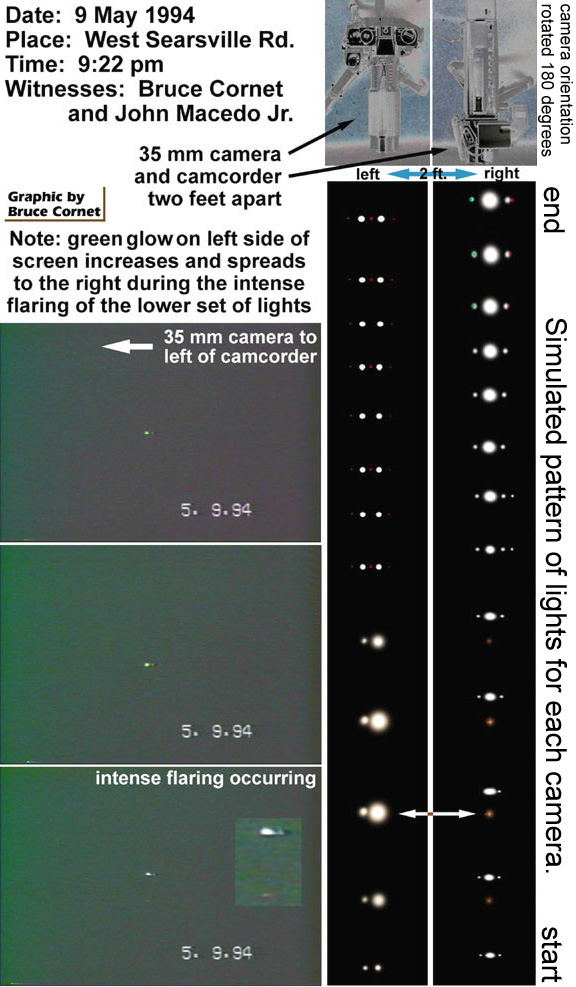
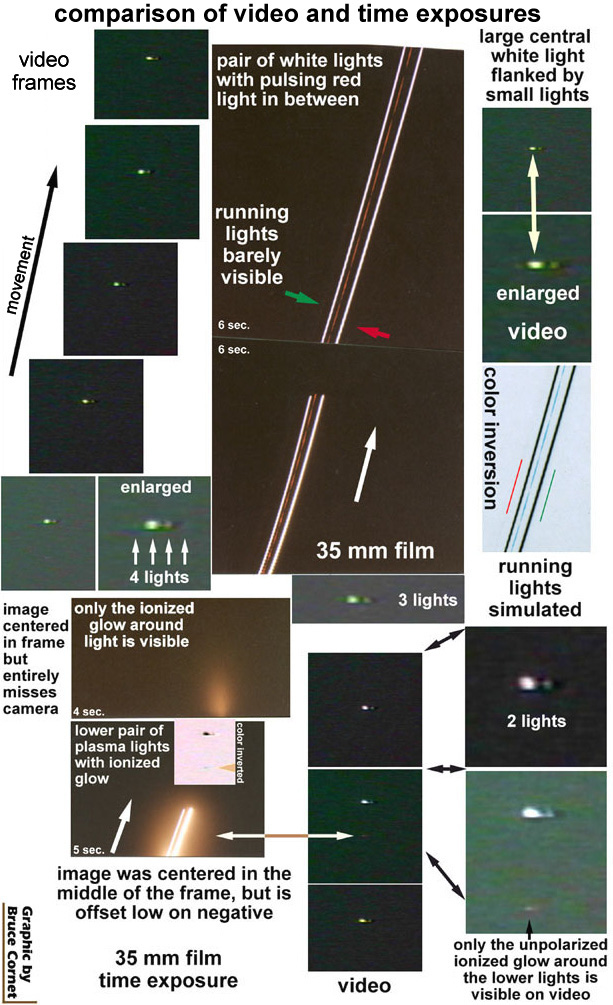
How does one explain two cameras capturing two different sets of lights, and two people seeing only the lights their cameras captured? When one examines the video carefully, something remarkable becomes evident. During the first time exposure, nothing can be detected on the video, but during the second time exposure, the light (image) somehow was bent downwards so that most of it did not get captured on film. When that happened, a faint brownish light or glow can be discerned below the main light on the video (occurs at ¥ in table above. An enlarged video frame in the lower right corner of Graphic No. 2 shows this glow clearly. It soon disappears in the video.
When Cornet saw the right light flare, it produced an orange glow around it, characteristic of Nitrous Oxide gas being produced by an intense plasma gas (see Plasma Orb). That glow was captured on his time exposure (photo no. 1 above). It is this glow that seems to have been captured by on video. Why only the glow? To answer that question we have to consider additional evidence:
Take a look at the three enlarged video frames on the left side of Graphic No. 1. Note the intense green glow on the left side of each video frame. Now look at photo no. 1 enhanced (below) in order to bring out a mirror-image artifact (green color distortion) on the right side of the time exposure.
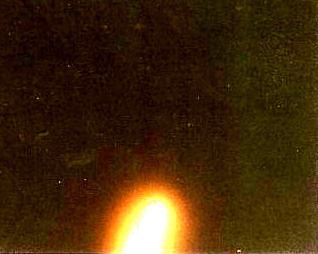
There appears to have been some sort of energy that affected the right side of the film in the camera and the left side of the videotape in the camcorder. That energy was capable of causing a magnetic (color) darkening on the videotape and an emulsion (chemical) color darkening on the 35mm film. The darkening is called wave interference.
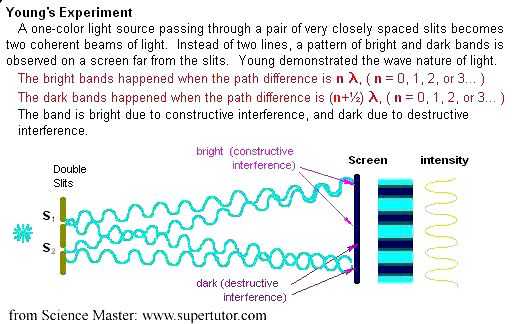
One possible explanation for this effect is that the images projected to each of the cameras was done using highly directional beams of energy - not unlike the beams in the Young's experiment above. You might say that the light was polarized, but not in a conventional sense, because there were no filters on the cameras which could make polarized light visible.
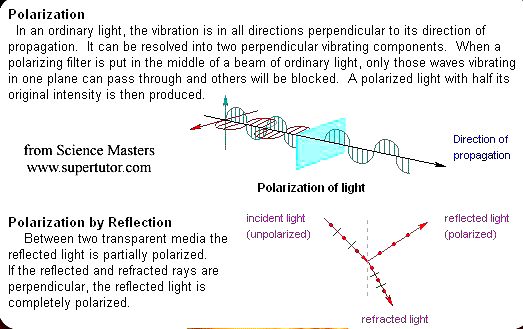
The energy beams were so focussed that Cornet could not see what Macedo saw, and Macedo could not see what Cornet saw. In addition, there was magnetic and/or photonic interference between the beams, since they were so close (magnetic for the video if the influence did not occur through the lens). That interference pattern extended far enough laterally to cause adjacent color distortions on the recording media.
But why then did the videotape pick up only the glow around the flaring lights Cornet saw? That's easy to explain. The glow or ionization of the air could not be controlled as well as the projected images. It therefore was not focussed, and both cameras picked it up. The position of the glow significantly below the main light in the video indicates the position from which the image Cornet saw and recorded was projected. For this feat to have been designed by humans would take the combined integration of highly sophisticated and expensive optical, infrared, night-vision, targeting electromagnetic beam technology - certainly something that 99.9+% of all human-designed aircraft do not have.
See also: Reality - The Holographic Universe - 3/16/97
THE UNIVERSE AS A HOLOGRAM
DOES OBJECTIVE REALITY EXIST,
OR IS THE UNIVERSE A PHANTASM?
Peer Review Questions and Answers
Q1: Could there be a conventional explanation for why the light was centered in the eyepiece, yet when developed it was lower in the emulsion frame?
A1: Not unless the reflex shutter door did not completely open (i.e. swing upwards and completely out of the optic path), blocking some of the light towards the top of the frame. The lens's collecting and focussing capability would still allow a partial image to form, but it would now be restricted to the bottom of the frame or top of the picture (the image is inverted by the lens). However, this is clearly not what happened - just the opposite. The light is restricted to the bottom of the image (top of frame), which would have been blocked by a shutter door which did not completely open.
Q2: Did you carefully examine the negatives to look for problems in developing the film? You most likely did, and you should explicitly say that in the webpage.
A2: Yes, the negatives were carefully
examined, and no developing anomalies were seen.
Q3: Could there have been any film advance anomalies with your camera during the
event?
A3: The off-center direction of the image is up-down, not left-right. The film advances or moves from right to left (facing front of camera), which is left to right for the inverted images on the negative. Off-center and down implicates a beam that was not perfectly centered on the camera lens. If a wide single beam had been centered on my eyes, and I raised my head above the camera body when I opened the shutter (which I did because the viewfinder image goes black), the beam (if wide enough) would enter the camera lens off-centered and towards the top of the lens. But the beam would then be off-center towards the top of the picture, not the bottom.
An alternative hypothesis is that the beam was
intentionally widened or split into two highly directional beams, one aimed at the camera
and the other aimed at the human observer. The computed angle of beam divergence in
order to hit both targets (lens and eyes) was off just enough to move the lower beam down
too much. By contrast, Macedo maintained sight of the AOP through the viewfinder of
the camcorder, and did not raise his head above the camera until he could no longer track
the AOP due to maximum tilt angle allowed by the tripod head.
Q4: On your camera, do the lens optics pass into the eyepiece, or are they separate?
Does the eyepiece show exactly what is in the FOV? With your camera, the answer is
probably yes, but I had to ask.
A4: Yes the lens optics pass into the
eyepiece. When the shutter door is closed, a mirror directs the optics upwards to
the viewfinder. The camera has a through-the-lens viewfinder. Had the shutter
door not been completely closed, which might account for an off-centered camera, stray
light would have been able to reach the film, causing some sort of detectable effect.
But since a light leak would be most apparent across the bottom of the camera body,
where the shutter door first rises, the effect would be along the bottom margin of the
picture, not up and down across the right side of
the picture.
Q5: Has the response properties of the optics in the SLR camera and video camera
been comparatively tested against a flat-field optical standard? Someone could argue that
the optical responses are different and the results you got were not unexpected.
A5: No comparative test was conducted.
However, the video camera was tested using a magnet held close to the side where
the recording head is located. The result was a color distortion on one side of the
videotape like that recorded for the AOP event. The camcorder does not have a white
balance control, like that of professional cameras. At no other time did the SLR
camera produce similar results where what was centered in the viewfinder ended up
off-centered on the film. Had that been the case on more than one occasion, the
camera would have been sent to the shop for repairs.
Q6: What are the optical specifications of the camera and the video recorder? It
would be useful to present them on the webpage and state exactly which settings (zoom
setting, etc.) were used during the experiment.
A6: The SLR camera had its 300 mm
telephoto lens set at maximum zoom or magnification. Interestingly, John did not use
the zoom on the camcorder. He kept the camcorder at its widest FOV (field-of-view)
angle, which is why the image captured is so small. In hind sight, I am glad he did
that, because the FOV angle can be calculated, whereas if he had used the zoom, I would
not be able to calculate how much magnification was used without a standard wide angle
shot for comparison.
Q7: If optical diffraction is occurring and causing interference patterns can you
present a graph showing that, at the distances involved, the interference pattern would be
detectable? If the AOP was 1000 feet away and the cameras were 2 feet apart, the angle
between the two cameras from that distance is: 1.99x10^-3 radians. If the AOP was farther
away, 1500 feet, the angle is 1.33x10^-3 radians. These are pretty small subtended angles,
and the patterns produced by interference may be at even smaller angles. You need to show
that at a range of 1000 to 1500 feet an interference pattern is resolvable with your
instruments.
A7: Interference patterns occur not at the source, but at some point between the source and destination (see graph above). If the two source beams were more closely spaced than two feet, the interference would occur near the source, but if the two beams were far apart, and converged on targets which were closely spaced, the interference would occur near or at the targets. See graph below. The question should be not whether an interference pattern could be resolvable, but how wide the beams had to be for them to be detected by both camera and observer when Cornet's head was raised above the camera body, but not two feet away. When Cornet saw one of the lights flare, the amount of energy being projected had to increase for it to ionize the atmosphere around that light. If beam width was affected by that increase in energy, we might have an explanation why the interference phenomenon becomes more apparent on the videotape during the flaring phase of the event (see Graphic No. 1). The beam targets (cameras) were spaced two feet apart. Since interference indicates overlap of two beam fields at (n + ½) l, beam width prior to the interference would have been a maximum of about 1.1 feet (interference not produced or detectable), and when detectable no more than about 1.2 feet in width. That additional width would have produced an interference pattern that extended to about 1.8 feet, or just inside the margin of view for both lenses, which are about 2 inches wide. Keep in mind that the beams converged at a significant angle (see below), interference could not occur except at the targets, and the field-of-lens-view is negligible if the interference occurred just in front of the camera lenses.
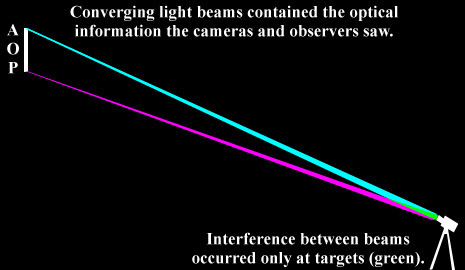
The data above imply that the two source beams were spaced one above the other, about 70% further apart than the width of the lights in the video. If the spread of those lights was similar to the distance of navigation lights on a conventional jetliner (range 82 to 165 feet, average 130 feet), the source beams originated from points as much as 220 feet apart, which would implicate two separate AOP unless the craft was oriented vertically, and projecting images from its nose and tail (which is possible given what we know about Pine Bush AOP and their flight characteristics). Because of its stealth black skin, observers on the ground would not have been able to make out its shape and orientation if there was only one AOP. If two AOP were involved, the inability of the observers to see an interconnecting structure is understandable. More than likely the spread of lights on the videotape was much less than the width of the AOP, because the images were projected (width was an illusion dependent on artificial magnification). If the light sources had been separated by 220 feet, the angle of beam convergence would have been 12.7degrees at 1,000 feet, 8.5 degrees at 1,500 feet, or 6.36 degrees at 2,000 feet. If the two source beams were half that distance apart, the angles would be halved.
As the AOP neared our position its lights
changed to the pattern in photos #3 and #4.
That change was probably a transition from projected images to real lights on the craft,
unless the beams could be directed downwards and backwards. Both Macedo and Cornet
saw the same pattern of lights as the AOP flew over them. Neither person could make
out its shape.
Q8: Was this observed characteristic of the AOP intentional or a side-effect of its
operation? This needs to be discussed a little.
A8: One can only evaluate the flight path
taken to determine any deviation from a straight (normal) flight path, which might be an
indicator of intent or purpose. The AOP descended rapidly (photo #5) after if flew over us, which is highly unusual
for conventional aircraft operation. That behavior alone would seem to indicate
that the event was not a side-effect of normal operation, especially if the AOP descended
in order to get below radar detection. If that is why it descended so rapidly, then
the effects were intentional and staged (i.e. a demonstration). Question is, how did
the pilot know that we were conducting an experiment for the very purpose of analyzing AOP
optical technology? Perhaps that question is rhetorical for those not afraid of the
"T" word.
Q9: Can you address at all the bending or refracting of light by an intensely
localized gravitational field? We know that gravity lenses exist and the position of star
light bending around a gravitational center is well documented. This should be mentioned
at least once as a possible cause.
A9: We know so little about focussed artificial gravitational fields that I probably should not hazard any speculation on what such a field might do. Had a gravitational field been focussed on our location which would be strong enough to bend light, I suspect that it would also have affected other material objects. In other words, we would have felt a significant change (especially in our ears, which are extremely sensitive to gravitational vectors) like going through G-forces, or our cameras might have moved.
The data presented above strongly implicates a technology capable of projecting a highly controlled beam of energy containing an image to a specific target. Each beam originates from a different location on the projection platform. The light within each beam has characteristics of polarized light, which can be seen only with an orientation filter. When two beams interact, they produce a third electromagnetic wave capable of affecting magnetic videotape. The interference wave is also capable of affecting the chemical emulsion on photographic film, but to a much lesser extent (as evidenced by the amount of contrast enhancement required to reveal the effect on the time exposure). The Manta Ray light and sound platform contains a battery of different size and different color lights across its plow-like bow. It is posited that the broad bow of the Manta Ray has ample room and depth for the location of multiple devices capable of projecting separate beams the distance apart on the video.
This technology appears to be far advanced beyond anything humans have invented to date. If you do not think so, prove me wrong.
Copyright B. Cornet 1999
Date this web page was last modified: 10/23/05